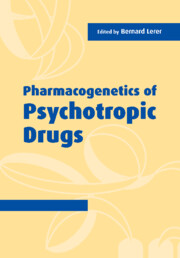Book contents
- Frontmatter
- Contents
- List of contributors
- Part I Introduction
- Part II Clinical background and research design
- 2 From pharmacogenetics to pharmacogenomics of psychotropic drug response
- 3 Neuropsychopharmacology: the interface between genes and psychiatric nosology
- 4 Methodological issues in psychopharmacogenetics
- 5 Statistical approaches in psychopharmacogenetics
- Part III Molecular background
- Part IV Pharmacokinetics
- Part V Specific psychotropic drugs and disorders
- Part VI Pharmacogenetics and brain imaging
- Part VII Industry perspectives
- Index
3 - Neuropsychopharmacology: the interface between genes and psychiatric nosology
from Part II - Clinical background and research design
Published online by Cambridge University Press: 20 August 2009
- Frontmatter
- Contents
- List of contributors
- Part I Introduction
- Part II Clinical background and research design
- 2 From pharmacogenetics to pharmacogenomics of psychotropic drug response
- 3 Neuropsychopharmacology: the interface between genes and psychiatric nosology
- 4 Methodological issues in psychopharmacogenetics
- 5 Statistical approaches in psychopharmacogenetics
- Part III Molecular background
- Part IV Pharmacokinetics
- Part V Specific psychotropic drugs and disorders
- Part VI Pharmacogenetics and brain imaging
- Part VII Industry perspectives
- Index
Summary
OVERVIEW
The observation that mental illness runs in families received substantial support in family, twin and adoption studies. Nonetheless, the heterogeneity within the diagnostic categories of schizophrenia and manic-depressive illness has precluded any meaningful research in the genetics of these disorders. To break the impasse in genetic research of mental illness, consideration was given to split psychiatric disorders into simpler biological or behavioral components. However, all alternative approaches fall short of psychiatric nosology in classifying mental illness in a clinically relevant manner. Neuropsychopharmacology has the unique capability of linking the effect of a psychotropic drug on mental illness with the effect of the substance on brain structures involved in the action mechanism of the drug. Since the primary targets of psychotropic drugs are encoded by genes that have been identified, any form of disease which corresponds with the treatment-responsive population to a psychotropic drug is suitable for the generation and testing of genetic hypotheses relevant to mental illness. To provide orientation points about what nosology could offer genetic research, the history of psychiatric nosology is reviewed and the varying constructs that can be used are illustrated. Kraepelin's (1899) diagnostic concepts of dementia praecox and manic-depressive insanity are artificially derived nosologic constructs, whereas Wernicke's (1899) classification was based on scientific developments that were to become the foundation of neuroscience.
Keywords
- Type
- Chapter
- Information
- Pharmacogenetics of Psychotropic Drugs , pp. 36 - 56Publisher: Cambridge University PressPrint publication year: 2002



